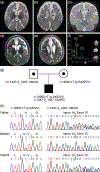Longitudinal MRI findings in patient with SLC25A12 pathogenic variants inform disease progression and classification
- PMID: 31403263
- PMCID: PMC6788951
- DOI: 10.1002/ajmg.a.61322
Longitudinal MRI findings in patient with SLC25A12 pathogenic variants inform disease progression and classification
Abstract
Aspartate-glutamate carrier 1 (AGC1) is one of two exchangers within the malate-aspartate shuttle. AGC1 is encoded by the SLC25A12 gene. Three patients with pathogenic variants in SLC25A12 have been reported in the literature. These patients were clinically characterized by neurodevelopmental delay, epilepsy, hypotonia, cerebral atrophy, and hypomyelination; however, there has been discussion in the literature as to whether this hypomyelination is primary or secondary to a neuronal defect. Here we report a 12-year-old patient with variants in SLC25A12 and magnetic resonance imaging (MRI) at multiple ages. Novel compound heterozygous, recessive variants in SLC25A12 were identified: c.1295C>T (p.A432V) and c.1447-2_1447-1delAG. Clinical presentation is characterized by severe intellectual disability, nonambulatory, nonverbal status, hypotonia, epilepsy, spastic quadriplegia, and a happy disposition. The serial neuroimaging findings are notable for cerebral atrophy with white matter involvement, namely, early hypomyelination yet subsequent progression of myelination. The longitudinal MRI findings are most consistent with a leukodystrophy of the leuko-axonopathy category, that is, white matter abnormalities that are most suggestive of mechanisms that result from primary neuronal defects. We present here the first case of a patient with compound heterozygous variants in SLC25A12, including brain MRI findings, in the oldest individual reported to date with this neurogenetic condition.
Keywords: AGC1; MRI; SLC25A12; genetics; intellectual disability.
© 2019 Wiley Periodicals, Inc.
Conflict of interest statement
CONFLICTS OF INTEREST
The authors declare no conflict of interest.
Figures


References
-
- Baslow MH (2003). N-acetylaspartate in the vertebrate brain: metabolism and function. Neurochem Res, 28(6), 941–953. - PubMed
Publication types
MeSH terms
Substances
Grants and funding
LinkOut - more resources
Full Text Sources
Medical
Molecular Biology Databases

